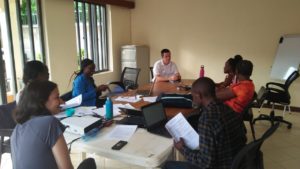 Last week the office at the Duke Center for Reproductive Health in Kisumu held a two-day qualitative research training session led by facilitators Cyrilla Amanya and Muli Emmanuel from ACE, Africa. Attendees included the Duke Reproductive Health Center’s Kisumu staff, a DGHI master’s student, and members of the Duke Global Health Institute’s (DGHI) Student Research Training Program (SRT). The members of SRT (Andrea Chalem, Suzanna Larkin, and I) are here in Kisumu, Kenya for 8 weeks working on two different studies concerning cervical cancer awareness, screening, and prevention. Andrea is working on an mHealth study with Jacob Stocks, a master’s student at DGHI, and Suzanna and I are working on a stigma study. We used the In-Depth Interviews (IDIs) created for the stigma project as a jumping off point for discussion and role play during the qualitative training session.
Last week the office at the Duke Center for Reproductive Health in Kisumu held a two-day qualitative research training session led by facilitators Cyrilla Amanya and Muli Emmanuel from ACE, Africa. Attendees included the Duke Reproductive Health Center’s Kisumu staff, a DGHI master’s student, and members of the Duke Global Health Institute’s (DGHI) Student Research Training Program (SRT). The members of SRT (Andrea Chalem, Suzanna Larkin, and I) are here in Kisumu, Kenya for 8 weeks working on two different studies concerning cervical cancer awareness, screening, and prevention. Andrea is working on an mHealth study with Jacob Stocks, a master’s student at DGHI, and Suzanna and I are working on a stigma study. We used the In-Depth Interviews (IDIs) created for the stigma project as a jumping off point for discussion and role play during the qualitative training session.
On day one, we learned helpful tips on how to make interviews conversational and comfortable for the participant. These included using the interviewee’s own language and referring back to their previous responses when asking follow-up questions. We discussed the importance of letting the informant lead by asking open ended questions and avoiding leading reactions. A slight change in wording can suggest to a participant that their answer is insufficient or incorrect. This became obvious through our role play exercises, as Jacob, in an attempt to play a “difficult interviewee” asked questions of the interviewer such as “Should I be worried about infection?” or “Is there something I’m not thinking of?” While these responses were all in good fun, this was an important reminder to avoid any leading language in a semi-structured interview.
During our second session, we learned about qualitative data analysis and reviewed important guidelines for coding qualitative data, keeping in mind that every single piece of knowledge granted to us by the participant is important. This session was a reminder that while a researcher may think that they fully understand a concept, discussing it in a research context can illuminate gaps in understanding. For instance, the difference between inductive and deductive reasoning may seem to be a concept that any given researcher implicitly understands. However, Muli defined inductive reasoning in the context of data collection as a method used when there is absolutely no background information behind one’s questions. This became a source of debate in the context of the stigma project that Suzanna and I are working on, which focuses on intersectional stigma between cervical cancer, HPV and HIV and aims to create a tool to measure this stigma. The creation of a tool to measure this specific type of stigma is a novel endeavor, which led me to consider our data analysis to be inductive rather than deductive. Muli disagreed and shared with us that our IDI questions were in fact deductive, due to the existing research on stigma in general.
Discussing and debating viewpoints in research is critical to ensuring a successful final product. I enjoyed this opportunity to focus our discussion on qualitative research alongside my esteemed colleagues here at the Center for Reproductive Health in Kisumu. Taking time to discuss the qualitative approach to research provided an excellent opportunity to learn more about research as an entity.
